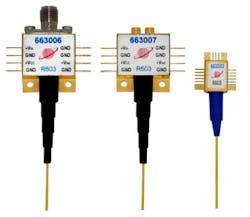Discovery Semiconductors’ Versatile Limiting Optical Receivers Ideal for Datacom Transmission Experiments
Discovery Semiconductors’ versatile PIN + TIA + Limiting optical receiver (DSC-R603) is ideally suited for Datacom applications up to 12.5Gb/s. It has an adjustable decision threshold, which allows changing eye crossing from 15% to 85%.
What is required are industry leading Optical Receivers to characterize Datacom transmission links in an… Easy-to-use, bench top instrument (Lab Buddy)… that allows rapid characterization of newer data center interconnect technologies… for faster transition to the commercial market place.
This Optical Receiver’s high differential conversion gain of 9,000 V/W and dual complimentary RF outputs allow for simultaneously driving a scope and BERT, as shown by Hewlett Packard Labs, Palo Alto, in 2015 Optics Express 23(26) 32968-32976.
Discovery’s limiting optical receivers are broadband, covering 800 nm to 1650 nm. They can be coupled with single mode or multimode fiber. Additionally, the DSC-R603, like all our photodetectors, is available in a fiber pigtailed module or an easy-to-use Lab Buddy instrument. Module packaging options include: miniature surface mount, female K connector or differential GPPO outputs.
Discovery Semiconductor’s Lab Buddy instrumentation includes built-in current limiting and sequenced biasing for turn-key operation. Furthermore, a 10Gb/s clock and data recovery (CDR) unit can be integrated with its Optical Receivers thus, providing a complete 3R receiver.
|
Discovery Semiconductors’ versatile PIN + TIA + Limiting optical receiver (DSC-R603) is ideally suited for Datacom applications up to 12.5Gb/s. It has an adjustable decision threshold, which allows changing eye crossing from 15% to 85%.
What is required are industry leading Optical Receivers to characterize Datacom transmission links in an… Easy-to-use, bench top instrument (Lab Buddy)… that allows rapid characterization of newer data center interconnect technologies… for faster transition to the commercial market place.
This Optical Receiver’s high differential conversion gain of 9,000 V/W and dual complimentary RF outputs allow for simultaneously driving a scope and BERT, as shown by Hewlett Packard Labs, Palo Alto, in 2015 Optics Express 23(26) 32968-32976.
Discovery’s limiting optical receivers are broadband, covering 800 nm to 1650 nm. They can be coupled with single mode or multimode fiber. Additionally, the DSC-R603, like all our photodetectors, is available in a fiber pigtailed module or an easy-to-use Lab Buddy instrument. Module packaging options include: miniature surface mount, female K connector or differential GPPO outputs.
|
Discovery Semiconductor’s Lab Buddy instrumentation includes built-in current limiting and sequenced biasing for turn-key operation. Furthermore, a 10Gb/s clock and data recovery (CDR) unit can be integrated with its Optical Receivers thus, providing a complete 3R receiver.
